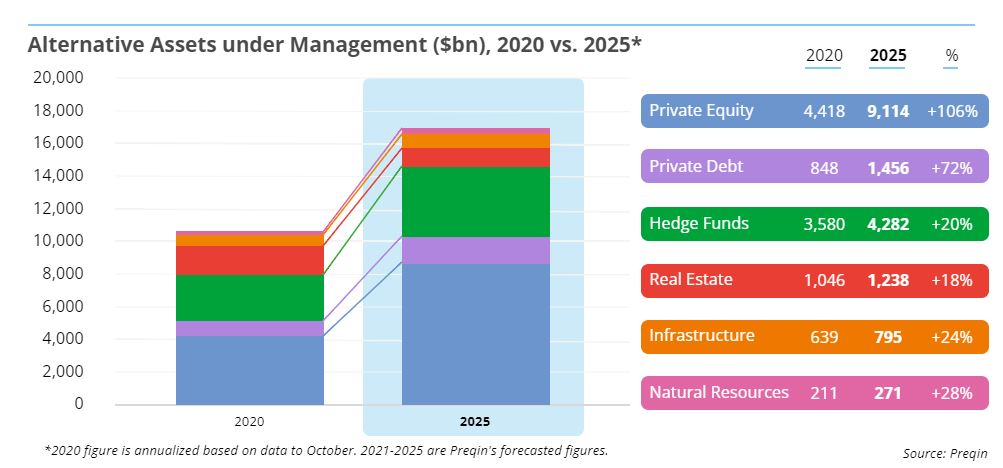Private Debt Growth Plugs into Investment in Operations
As the private debt market grows, so too does the need for technology, data and analytics solutions. Scott Turley, Vice President, Product Evolution, Asset Management at Broadridge Financial Solutions, Inc., explains the impact of such rapid growth and the tools firms are using to rise to the challenge.
Fueled by this asset class's strong returns amid a broader yield drought, the tsunami of capital entering private debt funds has accelerated over the last year. According to Boston Consulting Group, AUM overseen by alternative asset managers as a whole is projected to increase from $15 trillion in 2020 to $22 trillion by 2025. Private debt - comprised of direct lending, mezzanine, distressed debt and special situations funds – together with private equity are expected to be the main drivers behind the alternative industry's spectacular growth. Preqin added that private debt AUM is forecast to hit $1.46 trillion by the end of 2025, having already reached almost $1 trillion. As a result, private debt is now the third-largest private capital asset class behind private equity and real estate.

Although private debt fundraising has slowed – owing to growing competition and inflationary concerns – investors are still piling into distressed debt and special situations strategies. Preqin found that 51% of investors plan to commit fresh capital to distressed debt over the next 12 months, while 49% are targeting special situations.
Other alternative and traditional asset managers have taken note of the recent success of private debt, with hedge funds being one example. Although hedge funds outperformed the markets last year and provided investors with solid downside protection, a number of managers are increasingly conscious that they will need to diversify their businesses if they are to weather future crises. In response, many hedge funds are now launching private debt products as they look to widen the scope of their investment returns. As the number of hybrid firms swells, managers need to think carefully about how they run their operations.
How to manage data effectively
To manage operations effectively, private debt firms need to have access to consistent and easy-to-consume data. This can be achieved by using integrated or centralized systems instead of relying on a multitude of different, independent platforms. With information readily available in a single, central place, it will be easier for private debt firms to oversee investments together with vital risk management metrics such as credit modeling, liquidity projections and loss given default scenarios.
In addition to centralizing data, managers need to find effective ways of automating their data collection and normalization processes, not least because it can help them control costs. Manual processing is no longer acceptable for many institutional investors as it can increase the risk of errors or misreporting, both of which could have devastating consequences.
As a result, private debt firms need to invest in their technology infrastructure to enhance their client reporting. For instance, more managers are beginning to utilize private debt dashboards to visualize borrowers' data and produce detailed analysis – information that is subsequently shared with investors. Elsewhere, other managers are adopting real or near real-time reporting tools and making investment and risk data available to clients via their smart devices.
Although the private debt market is in healthy shape, fundraising is extremely competitive. Preqin said there are currently 592 funds in the market seeking out $300 billion from investors [as of April 2021]. If managers want to obtain mandates, they need to show that their client reporting processes are fit for purpose. At the same time, key decision-makers at institutional investors are getting increasingly younger and tech savvy, making it essential for managers to leverage best-in-class systems.
Investors cannot be taken for granted
Private debt is in a solid position, and it is an asset class poised to deliver strong returns over the next 12 to 18 months. Inevitably, this is leading to a spike in investor inflows, which in turn is prompting more managers from across the asset class spectrum – especially hedge funds - to launch private debt funds. Despite this bullishness around private debt, fundraising is not as straightforward as many experts would have you believe. Investors are very selective when awarding mandates, meaning managers need to demonstrate that they can deliver more than just returns. With clients now demanding regular, timely reporting that can be accessed easily through smart devices, private debt firms will need to improve their data management and data visualization processes if they are to rise to the challenge.
Article originally appeared in Alter Domus Sensus magazine issue 9.
Let’s talk about what’s next for you
Our representatives and specialists are ready with the solutions you need to advance your business.
Want to speak with a sales representative?
| Table Heading | |
|---|---|
| +1 800 353 0103 | North America |
| +442075513000 | EMEA |
| +65 6438 1144 | APAC |
Thank you.
Your sales rep submission has been received. One of our sales representatives will contact you soon.
Want to speak with a sales representative?
| Table Heading | |
|---|---|
| +1 800 353 0103 | North America |
| +442075513000 | EMEA |
| +65 6438 1144 | APAC |